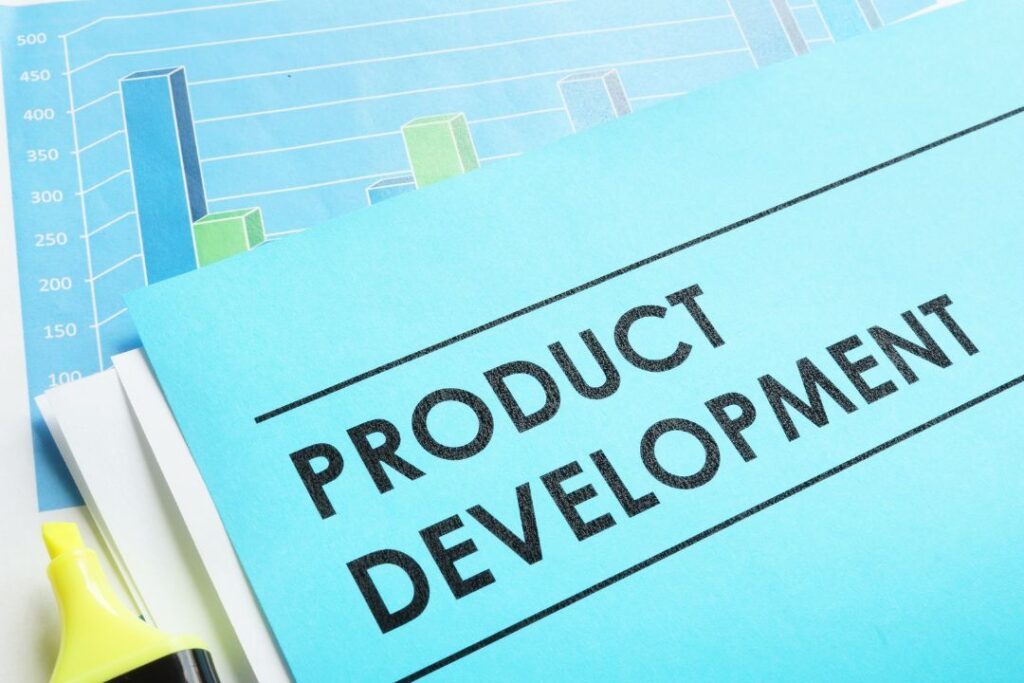In the world of e-commerce, the path to a finished product isn’t always a straight line. Even for successful businesses, product development can seem mysterious. How does a mere idea become a tangible product? This process involves market research, product management, and plenty of trial and error. In this guide, we’ll unravel the product development journey and provide you with strategies to bring your vision to life.
What is product development?

Product development encompasses the journey from idea to market. It also includes renewing existing products or introducing them to new markets. This involves identifying market needs, conceptualizing the product, building a product roadmap, launching it, and collecting feedback. New product development (NPD) specifically focuses on creating entirely new products and continues even after launch through user feedback and iterations.
Who handles product development?

In any company, product development involves various departments, including design, engineering, manufacturing, product marketing, UI/UX, and more. Each group plays a crucial role in defining, designing, building, testing, and delivering the product, making effective product management vital.
Creating a Product Development Plan

A product development plan, or strategy, guides a business through the product development process. It’s a detailed plan with milestones and checkpoints that keeps the team aligned toward the same goal until the product launches. Before you begin, put your plan in writing, considering timelines, deadlines, meeting frequency, and goals. Later in this guide, we’ll use this plan to map out mini-goals, workflows, and responsibilities for each stage.
Why is a product development plan important?

A product development plan is critical for several reasons:
- Aligns the team, fostering autonomy and unity.
- Establishes checkpoints, ensuring progress.
- Mitigates risk through thorough research.
- Defines success metrics.
- Encourages creativity within established guidelines.
The Comprehensive 7-Step Process for Developing New Products

The product development process can be broken down into seven stages: idea generation, research, planning, prototyping, sourcing, costing, and commercialization.
1. Generate an idea
Many aspiring entrepreneurs struggle with the initial stages of ideation and brainstorming. Often, they wait for a groundbreaking idea, but some of the best products come from building upon existing ones. The SCAMPER model, which prompts substitution, combination, adaptation, modification, repurposing, elimination, and rearrangement, can help generate innovative ideas. Business analysis also aids in understanding market opportunities.
2. Conduct market research
Validating your idea before production is crucial to avoiding failure. Methods include online surveys, crowdfunding campaigns, test marketing, Google Trends analysis, email opt-ins, pre-orders, forum feedback, and feasibility studies. Gather unbiased feedback and be cautious of relying on unconfirmed interest.
3. Develop a plan
Before creating a prototype, thorough planning is essential. Begin with a detailed sketch of your product, explaining its features. While a professional drawing isn’t necessary, you can outsource this to a technical illustrator. Create a list of required parts or materials and answer key questions about the product’s purpose, pricing, materials, packaging, and branding.
4. Create a prototype
Prototyping aims to create a finished sample for mass production. This involves experimenting with different versions of your product and refining it iteratively. You can prototype simple products like food recipes, cosmetics, or some fashion and jewelry designs yourself. For more complex items, consider third-party assistance or 3D rendering. 3D printing offers a cost-effective way to create physical samples.
5. Source Materials and Partners
After satisfying the prototype, gather materials and secure production partners. This builds your supply chain, which includes vendors, activities, and resources to get the product to customers. When selecting manufacturers or suppliers, consider storage, shipping, and warehousing; find multiple suppliers; attend sourcing trade shows; compare local and international sourcing; and explore similar Alibaba listings.
6. Determine costs
Calculate the cost of producing your product, including raw materials, factory setup, manufacturing, shipping, and additional costs like import fees and duties. Compare costs for different materials or manufacturers, and consider local vs. overseas production. Establish a pricing strategy based on your cost calculations.
7. Launch Your Product
Once your product is ready, it’s time to introduce it to the market. Hand over the reins to your marketing team for the product launch. You can run a successful go-to-market strategy through product launch emails, influencer partnerships, featuring in gift guides, enabling Instagram shopping, gathering early reviews, and more.
Conclusion
Every product’s journey is unique, and each industry has its quirks. If you encounter challenges, remember that every successful product faced similar obstacles. By following the steps in this guide, you can effectively navigate the process of bringing your new product to market. Regardless of what you’re developing, thorough preparation in researching, planning, prototyping, sourcing, and costing will set you up for a successful final product.
Related post: Business Strategy Demystified: What It Encompasses
















Discussion about this post